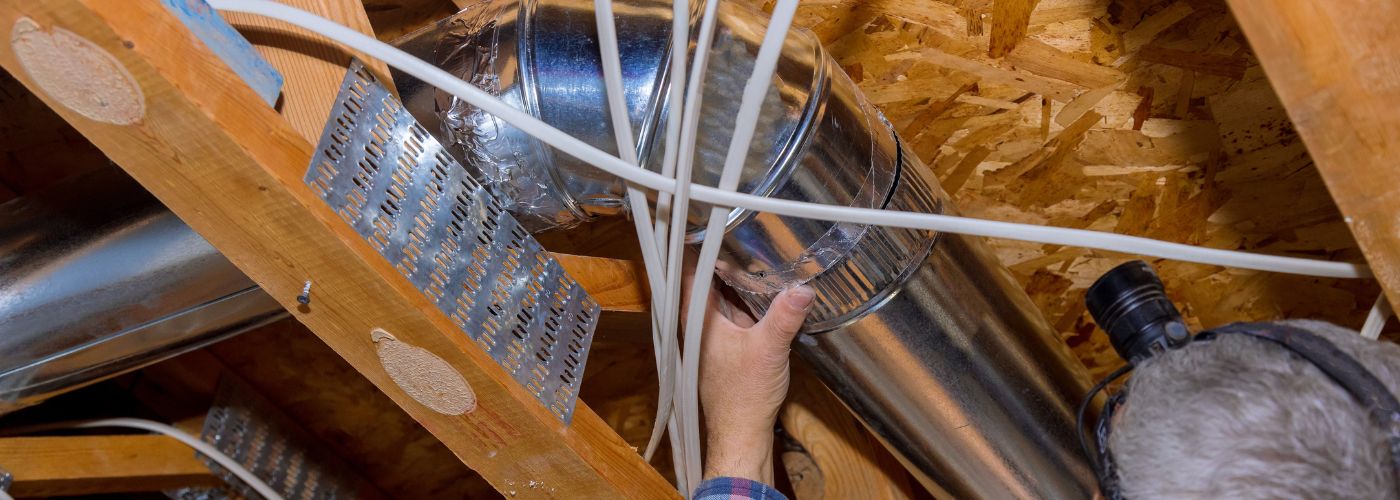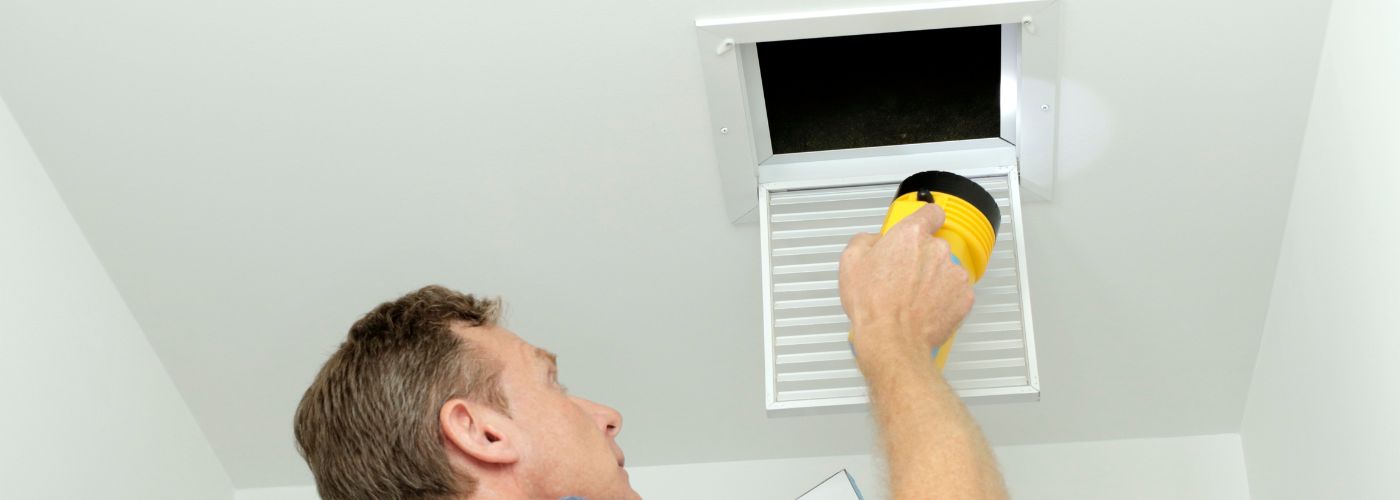Could your air ducts be hiding a serious health hazard? This article explains the warning signs of asbestos in your HVAC system—especially in older homes built before the 1980s. Learn how to recognize suspicious materials, understand the health risks, and know what steps to take if you suspect asbestos in your ductwork. Don’t risk your family’s safety—get informed and take action.
Key Points
- Homes built before 1980 are more likely to have asbestos in duct insulation or tape.
- Crumbling, dusty, or grayish materials around ducts could indicate asbestos-containing products.
- Disturbing asbestos can release harmful fibers—always call a professional for testing or removal.
As you sit back in the comfort of your home, breathing in the circulating air, have you ever stopped to consider what invisible particles might be lurking within your air ducts? The presence of asbestos in your air ducts is often overlooked. We’ll talk about the how to to identify asbestos within your ductwork.
Bad Signs Of Asbestos In Air Ducts
One of the most alarming signs of asbestos in air ducts is the presence of dust that appears white or grey in color. This could indicate the release of asbestos fibers into the air, posing a serious health risk to those exposed.
Additionally, if there are visible tears or holes in the ductwork insulation, this could be a sign that asbestos-containing materials are deteriorating and releasing fibers into the air stream.
Another red flag to watch out for is any discoloration or staining on the duct surfaces, as this could suggest water damage that has compromised asbestos-containing materials.
It’s crucial to take immediate action if you notice any of these signs in your air ducts, as exposure to asbestos fibers can lead to serious respiratory issues and even deadly diseases such as mesothelioma.
Regular inspections and maintenance of your HVAC system can help prevent these risks and ensure a healthy indoor environment for you and your loved ones.
Safe Ways To Remove Asbestos In Air Ducts
If you suspect that your air ducts contain asbestos, it is crucial to take immediate action to remove this harmful substance safely. One effective method is using asbestos duct tape, which involves coating the asbestos-containing materials with a sealant to prevent the release of fibers into the air.
Another safe approach is enclosure, where a physical barrier is installed around the asbestos-containing materials to prevent any disturbance. It’s important to hire a professional asbestos removal company that follows strict safety protocols and regulations to ensure a thorough and safe removal process.

When dealing with asbestos in air ducts, avoid attempting DIY removal as it can pose serious health risks. Professional contractors have the necessary expertise, equipment, and training to safely handle asbestos removal in air ducts.
Additionally, they will conduct thorough testing before and after removal to ensure that all traces of asbestos have been properly removed from your HVAC system.
By prioritizing safety and proper procedures during the removal process, you can protect yourself and your loved ones from the dangers of airborne asbestos fibers circulating within your home.
Best Air Duct Materials To Replace Asbestos
When it comes to replacing asbestos in air ducts, there are several safe and efficient materials to consider.
One popular option is fiberglass air ducts, which are lightweight, easy to install, and have excellent insulation properties. This makes a great attic insulation material since it keeps your home warmer and cooler!
Fiberglass also doesn’t release harmful particles into the air, making it a safe choice for indoor environments.
Another material worth considering is aluminum air ducts, known for their durability and resistance to corrosion. Aluminum ducts are non-combustible and can withstand high temperatures without deteriorating, making them suitable for a variety of heating and cooling systems.
Asbestos ductwork connectors are used during the removal process so that particles aren’t released into the air potentially compromising your air quality.
Additionally, aluminum is recyclable, making it an eco-friendly choice for those looking to reduce their environmental impact while ensuring clean and efficient airflow in their homes or buildings.
How Long Does Asbestos Last In Air Ducts?
Asbestos fibers can linger in air ducts for a surprisingly long time, with some estimates suggesting it can take up to 70 years for asbestos particles to naturally degrade.

This lengthy presence poses a serious health risk, as disturbed asbestos fibers can become airborne and be easily inhaled by building occupants. Furthermore, the accumulation of asbestos in air ducts can lead to ongoing exposure and potential respiratory issues over an extended period.
Regular inspection and maintenance of HVAC systems are crucial to ensure the safety of indoor environments!
How Long Does It Take For Air Duct Asbestos To Affect You?
Asbestos in air ducts can pose a serious health risk, but how long does it take for exposure to affect you? Some may experience symptoms like difficulty breathing or coughing soon after exposure, others may not show signs until years later.
These are just some of the many warning signs of asbestos in air ducts that you need to be aware of.
It’s important to note that asbestos fibers are microscopic and can easily be inhaled without detection. Once they enter the lungs, they can cause inflammation and scarring over time, leading to serious conditions like mesothelioma or lung cancer.
Therefore, if you suspect your air ducts contain asbestos or if your home was built before the 1980s when asbestos was commonly used in construction materials, it’s crucial to have them inspected and cleaned by a professional as soon as possible to minimize any potential risks to your health.
Stay informed and proactive when it comes to protecting yourself from this hidden danger lurking in your home’s air ducts.
When Is Asbestos In Air Ducts Disturbed?
Asbestos in air ducts may be disturbed during renovations or repairs that involve cutting, drilling, or removing insulation materials.
This can release asbestos fibers into the air, posing a serious health risk to anyone in the vicinity.
Additionally, aging ductwork or improper maintenance can also lead to the disturbance of asbestos fibers as the materials deteriorate over time.
Moreover, natural disasters such as floods or fires can cause significant damage to buildings and their infrastructure, including air ducts containing asbestos.
In these situations, it’s crucial for professionals to assess and properly address any potential asbestos contamination to ensure the safety of occupants and workers.
Frequently Asked Questions About Bad Signs of Asbestos in Air Ducts
What does asbestos in air ducts look like?
Asbestos in ductwork often appears as gray or white tape, wrap, or insulation that is brittle, dusty, or deteriorating. It may be found around joints, seams, or older furnace components.
Is it dangerous to touch asbestos duct tape or insulation?
Yes. Disturbing asbestos-containing material can release microscopic fibers into the air, which are hazardous when inhaled. Always avoid handling it yourself and contact a certified professional.
Can asbestos be safely removed from HVAC systems?
Yes, but only by a licensed asbestos abatement contractor. They will contain the area, safely remove the material, and dispose of it according to environmental safety regulations.
How can I know for sure if there’s asbestos in my ducts?
You’ll need a certified asbestos inspector to take samples and have them tested at a lab. Visual identification alone isn’t enough to confirm the presence of asbestos.
Will Lions HVAC inspect or replace ducts with asbestos?
While Lions HVAC does not perform asbestos abatement, we can help identify red flags and refer you to trusted, licensed professionals. Once the area is cleared, we can safely install new ductwork and improve your HVAC system.
Next Steps
Don’t ignore the signs when your health could be at risk.
If you suspect asbestos in your HVAC system, Lions Heating & Air is here to help. We’ll assess your ductwork, guide you to certified asbestos testing, and handle any duct replacement once your home is safe.
📞 Call 866-430-3950 or schedule an inspection online to protect your home and your family today.
